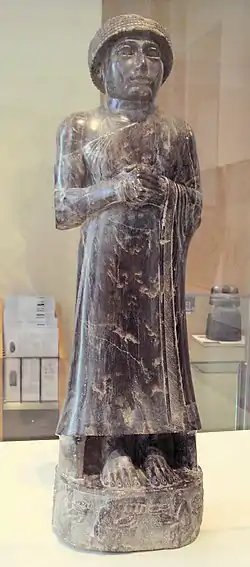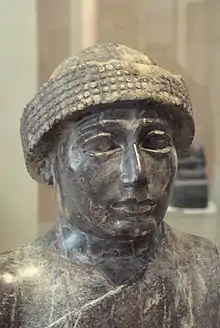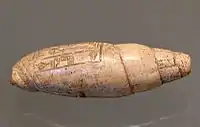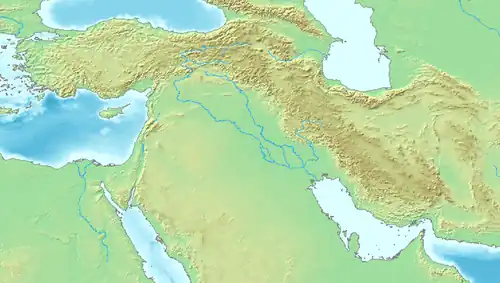| Ur-Ningirsu 𒌨𒀭𒎏𒄈𒋢 | |
|---|---|
| Ruler of Lagash | |
 Statue of Ur-Ningirsu, prince of Lagash. AO 9504 Louvre Museum. | |
| Reign | c. 2110 BC |
| Predecessor | Gudea |
| Successor | Ur-gar |
| Dynasty | Rulers of Lagash |
Ur-Ningirsu (Sumerian: 𒌨𒀭𒎏𒄈𒋢, Ur-D-nin-gir-su)[1] also Ur-Ningirsu II in contrast with the earlier Ur-Ningirsu I, was a Sumerian ruler (ensi) of the state of Lagash in Southern Mesopotamia who ruled c. 2110 BC. He was the son of the previous ruler of Lagash named Gudea.[2][3]
Statue of Ur-Ningirsu
A statue of Ur-Ningirsu, dedicated to Ningishzida (Sumerian: 𒀭𒎏𒄑𒍣𒁕, DNin-ḡiš-zi-da), is shared by The Metropolitan Museum of Art of New York, and the Musée du Louvre, as they own separately the head and the body of the statue, respectively.[3][4] The statue has an inscription in the back, which reads:
"For Ningišzida, his (personal) god, Ur-Ningirsu, ruler of Lagash, son of Gudea, ruler of Lagash, who built Ningirsu’s Eninnu, fashioned his (own) statue. I am the one beloved of his (personal) god; let my life be long - (this is how) he named that statue for his (Ningirsu’s) sake, and he brought it to him into his House"
— Inscription of Statue A of Ur-Ningirsu. AO 9504 Louvre Museum.[1]
 Portrait of Ur-Ningirsu. Louvre Museum.
Portrait of Ur-Ningirsu. Louvre Museum. Inscription on the back of the statue.
Inscription on the back of the statue. Ur-Ningirsu Ensi Lagashki, "Ur-Ningirsu, Governor of Lagash" on his statue
Ur-Ningirsu Ensi Lagashki, "Ur-Ningirsu, Governor of Lagash" on his statue_Louvre_Museum.jpg.webp) Tribute bearers (base of the statue).
Tribute bearers (base of the statue)._Louvre_Museum.jpg.webp) Tribute bearers (right side of the statue).
Tribute bearers (right side of the statue).
Other objects and inscriptions
Also found was a foundation cone describing Ur-Ningirsu's construction of several temples.[5]
 Inscribed shell bearing the name of Ur-Ningirsu. Louvre Museum.
Inscribed shell bearing the name of Ur-Ningirsu. Louvre Museum.
 Votive macehead in the name of Ur-Ningirsu (inscription upside down). British Museum, BM 86917.[7]
Votive macehead in the name of Ur-Ningirsu (inscription upside down). British Museum, BM 86917.[7] Another statue of Ur-Ningirsu, with the inscription ""For Ningišzida, his (personal) god, Ur-Ningirsu, ruler of Laagaš, son of Gudea, ruler of Lagaš... (broken)"
Another statue of Ur-Ningirsu, with the inscription ""For Ningišzida, his (personal) god, Ur-Ningirsu, ruler of Laagaš, son of Gudea, ruler of Lagaš... (broken)"
References
- 1 2 Inscription of Statue A of Ur-Ningirsu, body AO 9504, head MMA 47.100.86, in Edzard, Sibylle; Edzard, Dietz Otto (1997). Gudea and His Dynasty. University of Toronto Press. pp. 185–186. ISBN 9780802041876.
- ↑ Edzard, Sibylle; Edzard, Dietz Otto (1997). Gudea and His Dynasty. University of Toronto Press. pp. 7–8. ISBN 9780802041876.
- 1 2 Art of the First Cities: The Third Millennium B.C. from the Mediterranean to the Indus. Metropolitan Museum of Art. 2003. pp. 431-432. ISBN 9781588390431.
- ↑ "Un prince sumérien de retour à Paris - Ur-Ningirsu | Musée du Louvre | Paris". www.louvre.fr.
- ↑ "Sumerian Pottery Cuneiform Foundation Cone". LiveAuctioneers Archives. Retrieved 22 July 2020.
- ↑ "Metropolitan Museum". www.metmuseum.org.
- ↑ "Collection object details". British Museum.
Sources
- Dijk-Coombes, Renate Marian van. Portrait of a Ruler: The Portrayal of Ur-Ningirsu in Statuary and Inscriptions. pp. 358–381.
- "Ur-Ningirsu in the Metropolitan Museum of Art". www.metmuseum.org.

